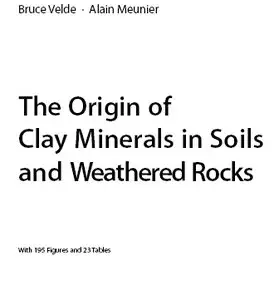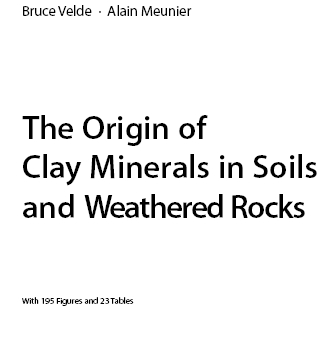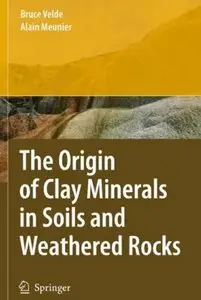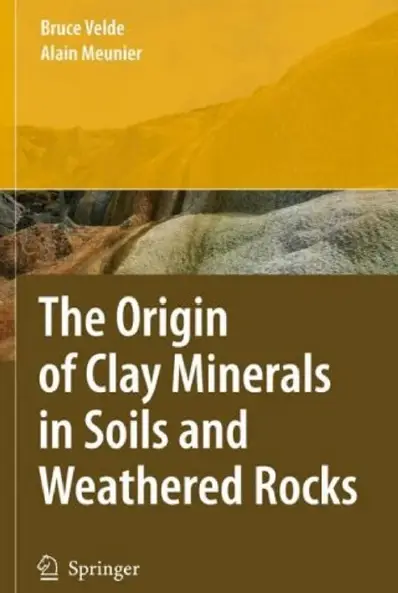"The Origin of Clay Minerals in Soils and Weathered Rocks" by Bruce B. Velde, Alain Meunier
Sрringеr | 2008 | ISBN: 3540756347 | 426 pages | PDF | 18 MB
Sрringеr | 2008 | ISBN: 3540756347 | 426 pages | PDF | 18 MB
This book aims to further a better understanding of such mechanisms, and it is thus destined for an audience of ecologists, pedologists, agronomists and other researchers involved in earth surface science
Knowledge of the origin and transformation of clay minerals, their dynamic response to changing chemistry, is the key to a rational use of this natural boundary which affects our lives. The information and the analysis presented here is an attempt to set trends of research in the direction of preventive and creative use of the plant – soil interface.
Clays are the product of slow transformations of high temperature rocks into reactive, fine grained material. This material, once in the sphere of plant interaction, becomes highly reactive with transformation periods of tens to hundreds of years. The challenge of the future is to use these rapid responses to the benefit of mankind.
Contents
Introduction
1 Fundamentals of Clay Mineral Crystal Structure and Physicochemical Properties
Introduction
1.1 The Common Structure of Phyllosilicates
1.1.1 From Atomic Sheets to Layers
1.1.2 Negatively Charged Layers
1.1.3 The Different Layer-to-Layer Chemical Bonds
1.2 Polytypes and Mixed Layer Minerals
1.2.1 Layers of Identical Composition: Polytypes
1.2.2 Layers of Different Composition: Mixed Layer Minerals
1.3 Crystallites – Particles – Aggregates
1.3.1 Crystallites: The Limit of the Mineralogical Definition
1.3.2 Particles and Aggregates
1.4 The Principal Clay Mineral Species
1.4.1 The Cation Substitutions
1.4.2 The Principal Mineral Species of the 1:1 Phyllosilicate Group
1.4.3 Principal Mineral Species of the 2:1 Phyllosilicates Group without Interlayer Sheet
1.4.4 The 2:1 Phyllosilicates with an Interlayer Ion Sheet (Micas)
1.4.5 Phyllosilicates with a Brucite-type Interlayer Sheet (2:1:1)
1.4.6 The Fibrous Clay Minerals: Sepiolite and Palygorskite
1.5 Typical Properties of Intermediate Charge Clay Minerals
1.5.1 Hydration and Swelling
1.5.2 The Crystallite Outer Surfaces
1.5.3 The Ion Exchange Capacity
1.6 Particularities of Clay Minerals: Size and Continuity
1.6.1 Clay Minerals are always Small
1.6.2 The Reduced Number of Layers in the Stacks Typical of Clay Minerals
1.6.3 From Order-Disorder to Crystal Defects
1.6.4 Composition Heterogeneity at the Scale of a Single Layer
1.7 How Do Clay Minerals Grow?
1.7.1 Phyllosilicate Growth Principles
1.7.2 Speculative Interpretation of Growth Processes – Crystal Morphology Relations
1.7.3 Nucleation Processes in Clay-Bearing Rocks
1.8 Summary: Clay Minerals in Soils and Weathered Rocks
1.8.1 The 2:1 Clay Structure and Its Importance in Soils
1.8.2 The Illitic Minerals in Soils and Weathered Rocks
1.8.3 Expandable Minerals (Smectites – Vermiculites)
1.8.4 Hydroxy Interlayered Minerals
1.8.5 Mixed Layer Minerals in Soils
1.8.6 Kaolinite and Kaolinite/Smectite Mixed Layer Minerals (K/S)
1.8.7 Allophane and Imogolite
1.8.8 The Non-Phyllosilicate Minerals in Soils and Weathered Rocks
1.8.9 Stability of Clay Minerals Formed under Weathering Conditions
Suggested Reading
2 Basics for the Study of Soil and Weathered Rock
Geochemical Systems
Introduction
2.1 Definition of the Systems
2.1.1 The Size of the Systems under Consideration
2.1.2 The Solutions in Systems of Different Size
2.2 The Physicochemical Forces Acting in the Systems
2.2.1 Basic Definitions
2.2.2 The Chemical Potential
2.2.3 A Particular Chemical Potential: The pH
2.2.4 The Oxidation-Reduction Potential (Redox)
2.3 Mineral Reactions in Alteration Systems
2.3.1 Conditions at Equilibrium
2.3.2 Kinetics of Alteration Reactions
Suggested Reading
3 The Development of Soils and Weathering Profile
Introduction
3.1 Physical Description of Soils and Weathering Profiles
3.1.1 The Development of Weathering Profiles
3.1.2 The Development of Soils
3.1.3 Conclusion in a YES or NO Question Series
3.2 Dynamics of the Alteration Process under Temperate Conditions: An Investigation Comparing Soil and Rock Alteration in Profiles
3.2.1 Alteration in Temperate Climates
3.2.2 Kinetics of Alteration Processes
3.2.3 Kinetics of Soil Formation
3.3 The Inter-Relation of the Dynamics of the Alteration-Soil Profile Sequence
3.3.1 Overview of Soil and Weathering Mineralogy
3.3.2 The Mineralogy of Soil Horizons
3.3.3 Mineralogical and Chemical Differences between Alteration and Soil Zones
3.4 What Are the Clay Mineral Assemblages?
3.4.1 Formation of Different Clay Mineral Phases in A Horizon
3.4.2 General Schema of Alteration Zone and Soil Relations
3.4.3 Overview of Alteration in the Soil Zone in Temperate Climates
Suggested Reading
4 Clay Mineral Formation in Weathered Rocks: Water–Rock Interaction
Introduction
4.1 Weathered Rock Profiles in Temperate Climates
4.1.1 Weathering at the Landscape Scale
4.1.2 The Parent Rock Control on Weathering Profiles
4.1.3 The Climate Control on Weathering Profiles
4.1.4 From Macro- to Microscopic Scale
4.2 The Internal Destabilization of Primary Minerals (Primary Plasmic Microsystems)
4.2.1 Porosity-Permeability and Microsystems in Crystalline Rocks
4.2.2 Petrography of Contact Microsystems
4.2.3 Petrography of the Primary Plasmic Microsystems
4.3 Mineral Reactions in the Secondary Plasmic Microsystems
4.3.1 Petrography of the Secondary Plasmic Microsystems
4.3.2 Clays Forming in Secondary Plasmic Microsystems
4.4 The Ultimate Weathering Stages
4.4.1 The Fissural Microsystems: Cutans
4.4.2 Accumulations (Absolute and Residual)
4.5 The Weathering of Porous Sedimentary Rocks
4.5.1 Glauconitic Sandstones
4.5.2 Weathering of Marls
4.6 Possible Models for Weathering Processes
4.6.1 From Heterogeneity to Homogeneity
4.6.2 Mass Balance and Weathering Rates
4.6.3 From Qualitative to Quantitative Models
4.7 Summary of the Water/Rock Interaction Clay-Forming Processes
Suggested Reading
5 Plants and Soil Clay Minerals
Introduction
5.1 Dynamics of Clay Reactions in the Soil (Plant/Clay Interaction) Zone of the A Horizon
5.1.1 Disequilibrium in Plant–Soil Zone Clays
5.1.2 Dynamics of Clay Reactions in the Soils
5.2 Clay Mineral Types in the Plant–Soil Interaction Zone
5.2.1 Illite
5.2.2 Kaolinite
5.2.3 Oxides and Oxyhydroxides
5.2.4 Mixed Layer Minerals
5.3 Soil Clay Mineral Assemblages by Ecological Type
5.3.1 Prairie Soils
5.3.2 Forest Soils
5.4 Chemical Control in Soil Horzion by Plant Action
5.4.1 Silica
5.4.2 Potassium
5.4.3 Element Loss and Element Gain
5.5 Agricultural Influences
5.5.1 Prairie Soil Clay Mineralogy in Agriculture
5.5.2 Effect of Fertilizer on Clay Minerals
5.5.3 Plants and Soil Clay Minerals: Some Thoughts for Further Consideration
Suggested Reading
6 Clays and Climate – Clay Assemblages Formed under Extreme Humidity Conditions
Introduction
6.1 Impact of High Rainfall on Clay Mineralogy
6.1.1 Soil Development as a Function of Rainfall
6.1.2 Very High Rainfall
6.2 Rainfall and Vitreous Rocks (Andosols)
6.2.1 Andosol Characteristics
6.2.2 Weathering Processes Affecting Vitreous Rocks under Constantly Humid Conditions
6.2.3 Mineralogy and Hydration State of Andosols
6.3 Weathering Trends as a Function of Time
6.3.1 Weathering Trends as a Function of Time under Tropical Conditions
6.3.2 Weathering Trends in Semi-Arid and Arid Climates
6.3.3 Summary
Suggested Reading
7 Physical Disequilibrium and Transportation of Soil Material
Introduction
7.1 Slope Effects and Physical Disequilibrium
7.1.1 High Slopes in Mountains
7.1.2 Moderate Slopes
7.1.3 Wind and Water
7.1.4 Movement of Coarse Grained Material
7.2 Fine Grained Material
7.2.1 Wind Transport and Loess
7.2.2 Reaction Rates due to Plant/Loess Interaction
7.2.3 River Transport and Salt Marsh Sediments
7.3 Catena Movement of Fine Grained Material on Slopes
7.3.1 Topographically Controlled Soil Sequences
7.3.2 Slope and Smectite Genesis (Catenas)
7.4 Summary
Suggested Reading
8 The Place of Clay Mineral Species in Soils and Alterites
Introduction
8.1 Where Clay Mineral Types Occur in Alterites and Soils
8.1.1 The 2:1 Minerals
8.1.2 Kaolinite and Kaolinite/Smectite Mixed Layer Minerals
8.1.3 Gibbsite
8.1.4 Iron Oxyhydroxides
8.1.5 Imogolite and Allophane
8.1.6 Chlorites
8.1.7 Palygorskite, Sepiolite
8.2 Clay Minerals Present in Soils as a Response to Climate
8.2.1 Physical Factors and Their Effect on Alteration and Soil Clay Mineral Facies
8.2.2 Weathering Trend (Water – Silicate Chemical Trends)
8.3 The Impact of Plant Regime on Clay Minerals in Soils
8.3.1 Reactivity of Clay Minerals in Ecosystems
8.3.2 Convergence of Soil Clay Mineralogies
8.3.3 Effect of Chemical Translocation by Plants on Clay Mineral Stabilities
8.3.4 Equilibrium and Disequilibrium of Soil Clays
8.4 The Structure of Alteration and Clay Formation
8.4.1 Water/Rock Interaction
8.4.2 Source Rock and Clays
8.4.3 Plant/Soil Interaction
8.4.4 Clay Transport
8.4.5 Kinetics of Clay Change in the Soil Zone
8.4.6 Minerals Present and Their Change in the Soil/Plant Interaction Zone
8.4.7 Conclusions
8.5 Perspectives for Clay Mineral Science in Surface Environments: Challenges for the Future
8.5.1 Soils and Crops
8.5.2 Soils as a Natural Safety Net for Modern Society
Suggested Reading
Annexes
Annex 1 – Polytypes
Definition
An Example: The Mica or Illite Polytypes
References
Annex 2 – Mixed Layer Minerals
Conditions of Interstratification
Random Stacking Sequence (R0)
Ordered Stacking Sequences (R1)
References
Annex 3 – Cation Exchange Capacity
The Chemical Reaction of Cation Exchange
Deviation from Ideality
The Variable Charges
References
Annex 4 – Hydroxy-Interlayered Minerals (HIMs)
The XRD Properties of Hydroxy-Interlayered Minerals
The Incorporation of Al Ions in the Interlayer Region of HIMs
The Crystallochemical Composition of HIMs
The Mixed Layer Model
Conclusion
References
Annex 5 – Phase Diagrams Applied to Clay Mineral Assemblages
Fundamentals
Clay Minerals: The Stable Phases at Surface of the Earth
References
Annex 6 – Kinetics
Fundamentals
The Fick’s Laws
Suggested Reading
References
Subject Index
with TOC BookMarkLinks





